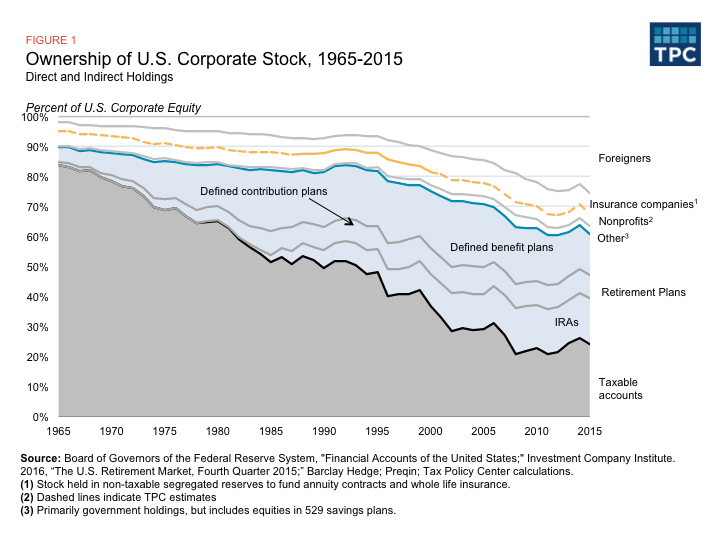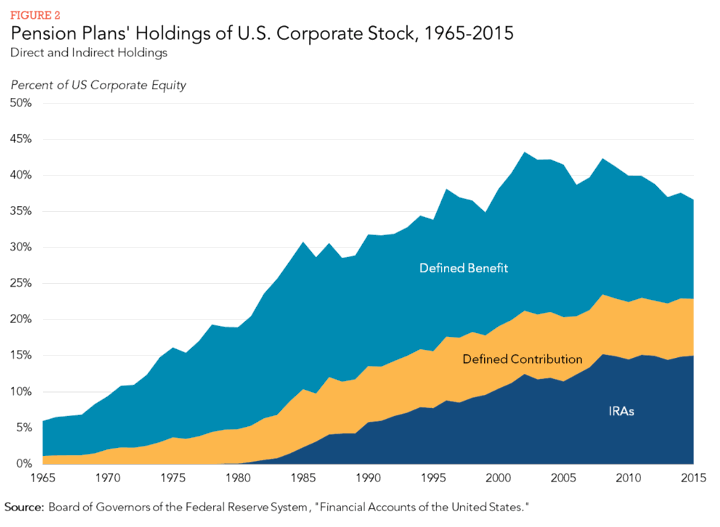If I was going for a clickbait title, I’d say “No one invests in taxable accounts anymore”. The Tax Policy Center has a new report by Rosenthal and Austin about how the share of U.S. stocks held by taxable accounts has dropped significantly over the last 50 years:

Here’s another view of how the share held by retirement plans has increased:

The current numbers:
- ~25% of US corporate stock is held in taxable accounts.
- ~37% of US corporate stock is held in IRAs, defined contribution (401k) plans, defined benefit (pension) plans.
- ~38% of US corporate stock is held by foreigners, non-profits, insurance companies, and other plans (governmental, 529 plans).
Between 1965-2015, the percentage held by taxable accounts dropped from ~85% to ~25%. The inverse finding is that the percentage held by tax-deferred retirement accounts and foreigners went from 15% to 75%.
That means that today, 75% of US stock owners may not care about the federal tax rates on dividend and capital gains, because it doesn’t affect them. Either they aren’t fully exposed to those taxes, or the taxes are deferred and withdrawals are tax at ordinary income rates. This trend could affect future tax policy.
 The Best Credit Card Bonus Offers – 2025
The Best Credit Card Bonus Offers – 2025 Big List of Free Stocks from Brokerage Apps
Big List of Free Stocks from Brokerage Apps Best Interest Rates on Cash - 2025
Best Interest Rates on Cash - 2025 Free Credit Scores x 3 + Free Credit Monitoring
Free Credit Scores x 3 + Free Credit Monitoring Best No Fee 0% APR Balance Transfer Offers
Best No Fee 0% APR Balance Transfer Offers Little-Known Cellular Data Plans That Can Save Big Money
Little-Known Cellular Data Plans That Can Save Big Money How To Haggle Your Cable or Direct TV Bill
How To Haggle Your Cable or Direct TV Bill Big List of Free Consumer Data Reports (Credit, Rent, Work)
Big List of Free Consumer Data Reports (Credit, Rent, Work)
From 2000 to 2015 the markets returned 8% over 15 years adjusted for inflation. Taxes are relatively irrelevant.
Although everybody’s individual tax situation differs in complexity and future scenarios are hard to predict, I would guess a lot of investors are going to find themselves paying taxes at higher ordinary income rates when they make withdrawals from their retirement plan than they would have if they had held assets in regular taxable account and incurred capital gains taxes. This struck home to me last year when the one stock mutual fund I hold outside of retirement plans declared a hefty capital gains distribution. I was dreading the impact this would have on my taxes but was pleasantly surprised to find that it was not that burdensome. It is something I will be taking into account going forward as far as where I direct my new investment dollars.
This is a great point. Long-term capital gains taxes can be much better than the income tax rate (under the current tax code). But there are also benefits to using tax deferred accounts to take advantage of tax deductions today. This allows investors to put away more money now compared to paying taxes first, then investing. Many people have compared investing with Traditional and Roth IRAs and looking at whether it’s better to pay taxes now or in the future. The answer, of course, depends upon the rate the money is taxed in the future. Which is unknown. 🙂
I don’t have those answers, so I’m trying my best to have a mix if traditional accounts, Roth accounts, and as you mentioned, some money in taxable accounts. All of that should offer a lot of tax diversification and long-term flexibility.
“That means that today, 75% of US stock owners may not care about the federal tax rates on dividend and capital gains” seems like a bad conclusion. People with strong financials are going to have many different accounts. Its fair to say they don’t care about tax rates on 75% of there assets, on average. Granted, your conclusion is probably right simply for an entirely different reason, the majority of the public is in a poor financial state.
This could also mean that after funding pensions, 401k, IRAs, 529s, instead of saving and investing their leftover money (if at all), blowing it away on buying stuff 🙂
This is interesting. But it makes sense when you think about it. The increase in the percentage of US stocks held in retirement accounts over time is most likely due to those accounts being more common than they were a few decades ago. The modern 401k plan wasn’t in place until 1981, when the IRS began allowing employees to use payroll deductions to fund their accounts. Even then, it took some time before these plans were widely adopted. IRAs came into being in 1974, and the Roth IRA came into being from the Taxpayer Relief Act of 1997.
So it makes sense to see that transfer of wealth from taxable investment accounts into tax deferred/exempt accounts. The baby boomers were hitting their prime earning years, pensions were going out of style, and investors were taking advantage of the tax breaks. Tax advantaged accounts are the default investment option for many people in the Gen-X, Gen-Y, and millennial demographics (at least until they max out those accounts and need to use taxable accounts for their investments).
I’m not sure I agree with your conclusion, “That means that today, 75% of US stock owners may not care about the federal tax rates on dividend and capital gains, because it doesn’t affect them. Either they aren’t fully exposed to those taxes, or the taxes are deferred and withdrawals are tax at ordinary income rates. This trend could affect future tax policy.”
We don’t know the break down of who owns which percentage of US stocks held outside of tax advantaged accounts. It could be that the majority of investors have most or all of their investments in tax advantaged accounts, and only the wealthy hold a large percentage in taxable accounts (because they have maxed out their retirement accounts).
Even then, I would say most people are still concerned about the federal tax rates on dividend and capital gains. But they have the ability to exert some control over their taxes with smart asset allocation and smart asset location. On top of that, there are many more efficient index and mutual funds today than there were even a few years ago, which can reduce the taxes in the current year. There are also some great tools investors can use to be more strategic with how and when they make a taxable event (determining which tax lot to sell, tax loss harvesting, and more).
Anyway, this is very interesting to see this chart laid out over time.